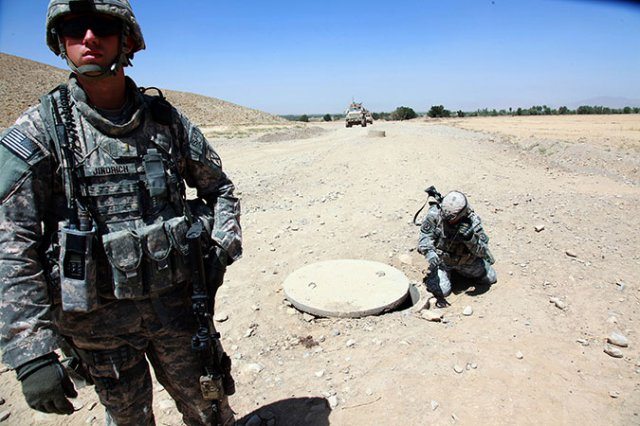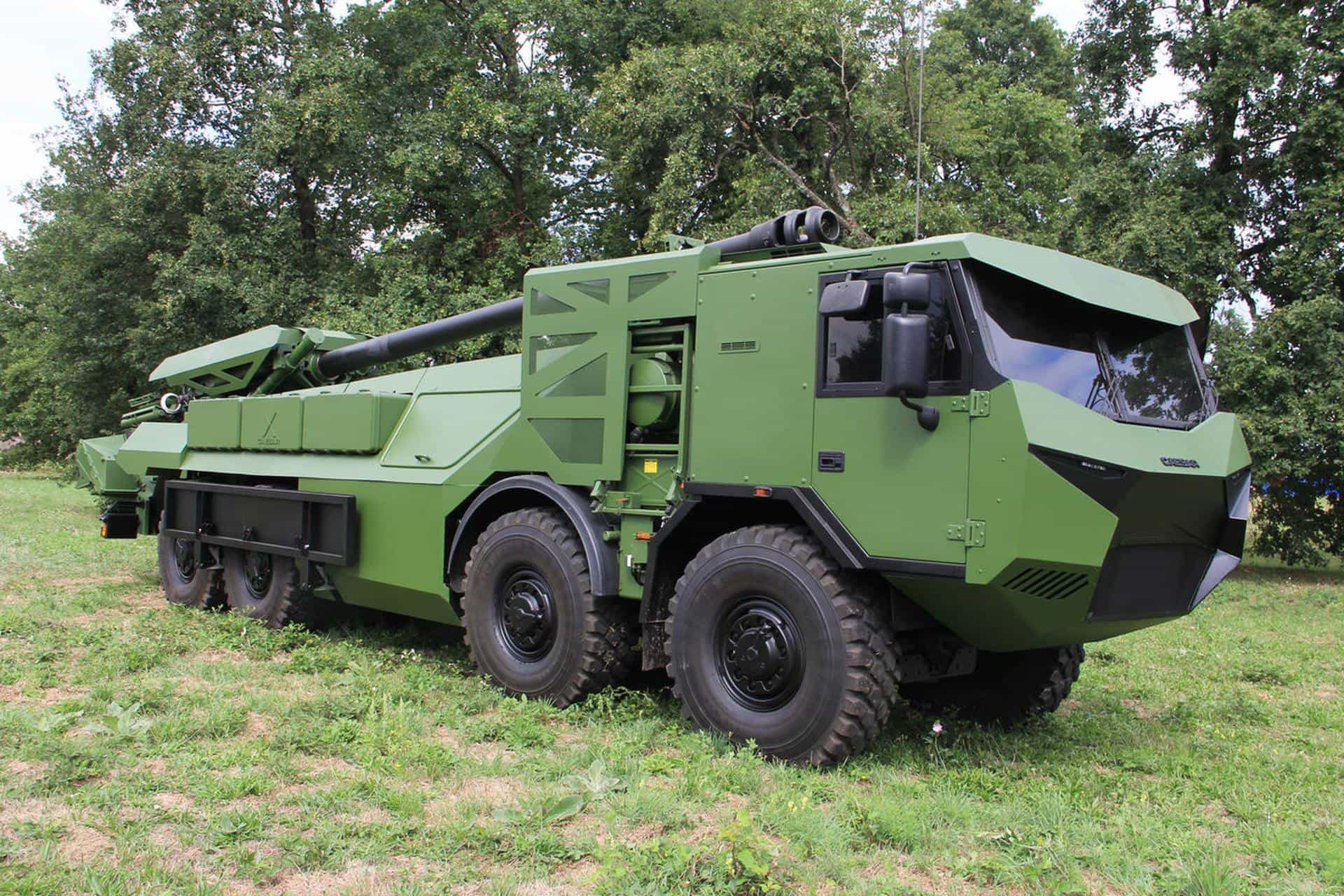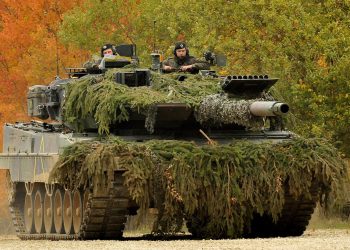New ballistic research areas are filling a critical gap in troop pelvic protection systems, said U.S. Army Research Laboratory engineers.
No standard scientific methodology currently exists to assess the performance of personal protection equipment, or PPE, against secondary debris, such as flying rocks, and bomb fragments ejected after a buried improvised explosive device, or IED, detonates, said Tyrone Jones, a mechanical engineer in Army Research Laboratory’s, or ARL’s, Weapons and Materials Research Directorate, or WMRD.
ARL teamed with the Program Executive Office Soldier, known as PEO Soldier, Natick Soldier Research, Development and Engineering Center, Joint IED Defeat Organization and the British Ministry of Defence to provide the Army with a technical tool to evaluate the PPE against this spectrum of threats.
In 2010, ARL began developing a novel lab scale test methodology to reproduce the soil conditions from buried IEDs, and then consistently launch the surrogate soils via a sabot from a medium-caliber smooth-bore gun, called the sand cannon.
The test methodology quantifies the debris-resistant performance of various fabrics such as Kevlar and jersey knitted silk, to be integrated into current PPE within a highly controlled environment. From here, Jones said, researchers can understand and readily identify the penetration mechanisms of the secondary debris into a prospect material.
ARL tested candidate materials provided by NSRDC leading to an improvement in the “ballistic boxer shorts” the military fielded last summer under its formal name, the Pelvic Protection System, as a response to the growing number of Soldiers on foot patrol sustaining injuries to the groin caused by IED blasts, and secondary debris. As of March 2012, more than 15,000 Soldiers had received the Army’s Pelvic Protection System.
The previous pelvic protection system was designed to protect against numerous and obvious Soldier threats, including small arms fire, thermal and environmental, but much of it can’t fully stand up against the tiniest of culprits — soil particulate and small debris — that en masse, can cause irreversible medical damage to soft tissue to include internal bleeding.
“Wound management is a critical part of medical care for dismounted Soldiers that are injured by buried IEDs,” said Jones. “Secondary debris, including soil ejecta, from buried explosive devices can lead to severe contamination and debridement issues for wounds and adds to the complexity of the first response care of stabilizing the primary wound.”
Col. James Jezior, chief of urology at Walter Reed National Military Medical Center in Bethesda, Md., said it’s not too difficult to tell the difference between a blast injury and a high velocity or gunshot wound type injury.
“The patterns of injury are much different between the two,” Jezior said. “Whether we see the fragments from the actual armament or whether there is secondary debris from things around or from the vehicle or from clothes, I don’t think that’s quite as easy to tell. It’s probably in many of the cases a mixture of those things that are eventually embedded in tissue or are part of the injury mechanism.”
ABOUT THE SCIENCE
Secondary debris testing involves complete analysis of live-fire blast data and soil mechanics, in addition to knowledge and experience in ballistics.
“ARL is the world leader in the characterization of blast, soil effects and terminal ballistic effects caused by fragments and secondary debris,” Jones said. “With this fundamental understanding, ARL is able to design repeatable methods and procedures to simulate these blast conditions in order to develop protection solutions.”
From the science, ARL is able to identify the relevant dynamic soil components and variables that inflict the damage on target during live-fire blast testing, and translate these components and variables into a debris simulant that can be consistently reproduced in a laboratory environment.
Typical sand-cannon tests involve a 25.4mm smooth-bore barrel gun firing “surrogate” soil load into a ballistic gelatin block designed to represent a body surrogate. Candidate materials were place in front of the gelatin block. The soil “cloud” travels through the material and into the gelatin block. The amount of soil retained by the gelatin block and the depth of penetration into gelatin block gives a measure of insult, or damage the secondary debris can cause.
“Bulk aggregate presents a very different threat than a discrete fragment or rock,” said Jones. “We are investigating how this threat interacts with a spectrum of materials, focusing on personal protective equipment and clothing so that revolutionary protective material breakthroughs can be achieved.”
He said surrogate soil is actually a 36-grit garnet abrasive blasting particulate selected because of its consistency of grain size and distribution, lack of moisture variability, individual grain hardness, availability in bulk, and easily obtainable specification.
“We use a high speed Phantom v7.1 video camera to capture the dynamic elements such as grit cloud flyer diameter and length, velocity and depth of penetration into the gelatin up to 160,000 frames per second. The high speed video camera captures the launch and penetration process in slow motion, measuring test variables and detailing revealing dynamic mechanism and verifying consistency in our test execution. Finally, the use of powerful 3-D microscopes can be used to analyze the architecture of the protective materials before and after impact, to aid in understanding the terminal ballistic effects of the interaction,” said Jones, who received a Bachelor of Science and Master of Science in Mechanical Engineering from Rensselaer Polytechnic Institute (RPI), and a Master of Science in Acoustics Engineering from Pennsylvania State University.
Integration, teamwork strengthen research
Just as ARL began developing this methodology, the British Ministry of Defense began deploying pelvic protection for its Soldiers deployed in Afghanistan, with the aim of reducing the number and extent of injuries from secondary blast. Dr. Mike Dalzell began a two-year ESEP exchange program with the ARL on the heels of previous assignments with the U.K.’s Defence Science and Technology Laboratory where he investigated Soldier protection solutions against blast and fragmentation.
“Fundamentally, our role in this is to understand the underpinning science and technology of the threat itself, how explosive charges interact with the soil then with the target, but also the fundamental mechanical properties of the materials that are acquired to stop these threats,” Dalzell said. “Secondary to that of course, we also have to understand the properties in the materials that are necessary to ensure the Soldier is not excessively burdened by wearing the protective technologies, so we’re interested in, for example, comfort, thermal burden, flexibility and so on.”
This methodology would eventually provide PEO Soldier with an evaluation tool used to understand how materials perform against a range of threats, and provide measurable insight on other important material factors such as breathability, thermal resistance and comfort that affect the Soldier’s ability to function and execute their mission.
This information would be used to assist the material community in the development of new materials that provide better protection at less weight, and it can be used to develop techniques and procedures that provide Soldiers with methods to increase survivability.
The methodology has already been provided to the Natick Soldier Research, Development and Engineering Center with an initial screening of candidate protective materials for potential incorporation into Army Combat Uniform pants. This methodology would support ongoing evaluations within the Army and Defense Department to determine which materials provide the most protection, while minimizing weight and bulk.
Dalzell said working with ARL presented “an opportunity there to get some collaboration between the U.K. and the U.S. on the particular subject. So I worked with the division and branch chiefs in WMRD to see if we could put together a program to support the U.S. Army’s own efforts developing pelvic protection for their own Soldiers.”
He said he’ll take some of the different and unique techniques learned in ARL back with him to apply on U.K. research projects.
“It’s been really great to work with ARL, especially within WMRD, with the shear breadth and depth of the scientists working there. I’ve had the opportunity to conduct a whole range of testing with a multitude of experts here to really get a different perspective on the problem. I think it’s important as scientists and engineers, we sometimes tend to look at things from our perspective but to get a different perspective from my colleagues here in the U.S. has been really worthwhile.”










